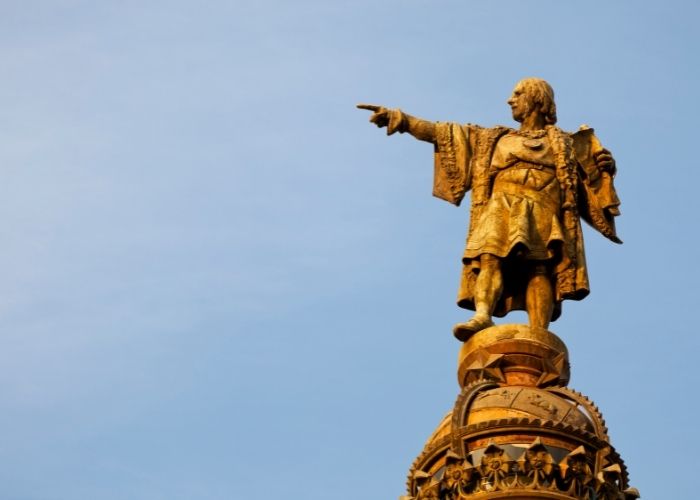For generations, we have been taught that Christopher Columbus was the first European to discover America from Spain in 1492. Yet there is evidence that Vikings crossed the Atlantic earlier and settled in the north of the continent in 1021. The findings were published in the scientific journal Nature.
Columbus and his crew thought they had found a new route to the Indies. However, it later emerged the route had taken their ships to the New World. There is now increasing evidence it was the Vikings, and not ‘Columbus, who first set foot in these exotic lands. They would have crossed the Atlantic Ocean from Greenland half a millennium earlier and settled in what is now Canada. The Vikings left notches with their axes in a number of trees in the north of the continent. This would be the proof. The Vikings used their axes to chop wood and use it to build their villages, weapons, and ships.
Icelandic sagas
The Vikings sailed long distances: in the west, they established settlements in Iceland and Greenland. But, as Icelandic sagas tell, the group led by leader Erik the Red reached even further than Greenland. They reach the American continent! However, these were the stories of the Viking people passed on orally from father to son. And are somewhere between fantasy and reality. A little after the year 1000, they founded the village of Leifsbudir. A small settlement of around 60 people lived there for several years. However, bad weather conditions and clashes with the natives forced them to return to Greenland.
Buried in a myth
The story remained a myth. At least until 1960, when Norwegian researcher Helge Ingstad and his wife, archaeologist Anne Stine Ingstad, discovered some strange bumps in a field at L’Anse-aux-Méduses (Jellyfish Inlet) in Newfoundland, Canada. Beneath the grassy soil lay the ruins of the ancient settlement of Leifsbudir, with at least three huts, a smithy, a sawmill to supply the shipyard, and three warehouses. Hundreds of utensils characteristic of Norse culture were also found. These included sewing utensils, indicating the presence of women and a stable settlement.
Carbon dating
The surprise was complete when the ruins were dated. Carbon dating showed they were built around the year 1000, almost 500 years before the arrival of Columbus, and at the time of the adventures of Erik the Red.
‘With this method, there can be a margin of error of two centuries, more or less the length of the Viking period,’ says Michael Dee of the University of Groningen and leader of the research. That is why his team went to work to detail the time.
They discovered traces of a solar storm from 993 in the tree trunks. ‘In recent years, it has been discovered that radiocarbon levels in the atmosphere have increased dramatically due to massive solar storms,’ Dee notes. These are then absorbed by the trees and ‘corralled’ into the growth ring of that year. Subsequently, much work has been done to attribute the rings to the year 1021.
At the moment, that is the only scientific proof that Vikings were there in that year, but not that they were there the rest of the time,’ says Dee. Scientists have also shown that the Viking people were the first to cross the Atlantic, a time when mankind’s migration routes circled the entire planet.
‘We knew that one of these peaks occurred in 993 AD, and this signal has been observed in tree rings all over the world. That’s why we explicitly looked for this sign in the wood remains in L’Anse-aux-Méduses,’ says Dee.
Looking for wood
The team suggests that there may have been hundreds of Vikings. With the men in the majority, although there may have been some women too. We know that their society was very stratified, with different social classes. And we can also deduce that they were in North America to get wood, which was scarce in their colony in Greenland,’ says Dee.
Short visits
The number of Viking expeditions and their duration is unknown, but from the current data it seems that, as the legends show, the Viking journeys were short. This is probably the reason for the limited physical, cultural and ecological evidence left by the Vikings on the ‘New Continent’. ‘Nevertheless, there is botanical evidence from L’Anse aux Méduses that confirms that the Vikings explored further south than Newfoundland,’ say the researchers. We may find similar evidence that helps us reconstruct where else the Vikings went,’ says Dee, who notes that there are already hypotheses that the Vikings also visited other places in Canada, ‘although this is hotly debated’.
Magic or myth?
Perhaps the journey of Erik the Red’s troops does not detract from the adventures of Christopher Columbus’ expedition. Even if his legacy turns out to be a myth. For the time being, the discovery of the New World is commemorated every year in Spain.
Related post: A brief history of Spain – part 7, Los Reyes Católicos (1469-1516)


